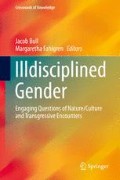Abstract
The chapter introduces the concepts of interstitial spaces and transgressive identities to examine the boundaries of gender and feminist studies, science, and education and discuss our research practices and positions. We use a metalogue as the vehicle for analyzing our autobiographies to provide examples when we have operated in interstitial spaces and engaged transgressive identities. Interstitial spaces exist between and within boundaries. These spaces are possible sites within a defined context (a discipline, a practice, a culture) that may be occupied by an actor/agent working as a “carrier” of different cultural practices, knowledge, and theories. A “carrier” can use the interstitial space to influence and challenge a “new” context and thus loosen up boundaries but can also by experiencing new cultures and developing new knowledge return to the “old” culture to integrate these new practices. Thus, interstitial spaces establish a context for transgressive identities to emerge so one can act in ways to transform and change the cultures of disciplines. We use transgressive identities as a theoretical description and understanding of our research practices and positions.
Access this chapter
Tax calculation will be finalised at checkout
Purchases are for personal use only
Notes
- 1.
For example, in the United States, the “committee of ten” decided that high school students would first study biology, followed by chemistry and then physics. Scientists in the nineteenth century introduced this “layer cake” approach to the curriculum which remains dominant in the twenty-first century (DeBoer 1991).
- 2.
Interstices are another name for interstitial spaces.
- 3.
Chafing can cause irritation but is also an action that may smooth rough surfaces.
- 4.
Realexamen in Swedish.
References
Barad, K. (2003). Posthumanist performativity: Toward an understanding of how matter comes to matter. Signs, 28, 801–832.
Birke, L. (2000). Feminism and the biological body. Trenton, NJ: Rutgers University Press.
Code, L. (1995). Rhetorical spaces: Essays on gendered locations. London: Routledge.
DeBoer, G. (1991). A history of ideas in science education. Implications for practice. New York: Teachers College Press.
Haraway, D. (1997). Modest_Witness@Second_Millenium.FemaleMan_Meets_OncoMouse. London: Routledge.
Harding, S. (1986). The science question in feminism. Ithaca, NY: Cornell University Press.
Hirdman, Y. (1990). Genussystemet. In SOU 1990:44, Demokrati och makt i Sverige. [Swedish Government Official Report, SOU 1990:44 Democracy and Power in Sweden] Stockholm.
Hoffman, N. (2003). Women’s true profession. New York: Harvard Education Press.
Hussénius, A., Scantlebury, K., Andersson, K., & Gullberg, A. (2013a). Ignoring half the sky: A feminist critique of science education’s knowledge society. In N. Mansour & R. Wegerif (Eds.), Science education for diversity in knowledge society (pp. 301–316). New York: Springer.
Hussénius, A., Andersson, K., & Gullberg, A. (2013b). Integrated gender teaching – Within subject courses in teacher education. In A. Lundberg & A. Werner (Eds.), Gender studies education and pedagogy (pp. 19–23). Gothenburg: Swedish Secretariat for Gender Research.
Keller, E. F. (1985). Reflections on gender and science. New Haven: Yale University Press.
Kumashiro, K. K. (2000). Toward a theory of anti-oppressive education. Review of Educational Research, 70, 25–53.
Lemke, J. (1990). Talking science: Language, learning, and values. Norwood, NJ: Alex.
Lykke, N. (2010). Feminist studies. A guide to intersectional theory methodology, and writing. London: Routledge.
Roth, W.-M. (Ed.). (2005). Auto/biography and auto/ethnography: Praxis of research method. Rotterdam: Sense Publishers.
Roth, W.-M., & Tobin, K. (2004). Co-generative dialoguing and metaloguing: Reflexivity of processes and genres. Forum Qualitative Sozialforschung/Forum: Qualitative Social Research, 5. Retrieved from http://www.qualitative-research.net/index.php/fqs/article/view/560.
Scantlebury, K. (2005). A snake in the nest or in a snake’s nest: Peer review for a female science educator. In W.-M. Roth (Ed.), Auto/biography and auto/ethnography: Praxis of research method (pp. 331–338). Rotterdam: Sense Publishers.
Scantlebury, K., & Martin, S. (2010). How does she know? Re-envisioning conceptual change from feminist perspectives. In W.-M. Roth (Ed.), Re/structuring science education: Reuniting sociological and psychological perspectives (pp. 173–186). New York: Springer.
Stengers, I. (2000). The invention of modern science. Minneapolis, MN: The University of Minnesota Press.
Tauber, A. I. (1994). The immune self: Theory or metaphor? Cambridge: Cambridge University Press.
Valian, V. (1998). Why so slow? The advancement of women. Cambridge, MA: MIT Press.
Author information
Authors and Affiliations
Corresponding author
Editor information
Editors and Affiliations
Rights and permissions
Copyright information
© 2016 Springer International Publishing Switzerland
About this chapter
Cite this chapter
Hussénius, A., Scantlebury, K., Andersson, K., Gullberg, A. (2016). Interstitial Spaces: A Model for Transgressive Processes. In: Bull, J., Fahlgren, M. (eds) Illdisciplined Gender. Crossroads of Knowledge. Springer, Cham. https://doi.org/10.1007/978-3-319-15272-1_2
Download citation
DOI: https://doi.org/10.1007/978-3-319-15272-1_2
Publisher Name: Springer, Cham
Print ISBN: 978-3-319-15271-4
Online ISBN: 978-3-319-15272-1
eBook Packages: Social SciencesSocial Sciences (R0)

